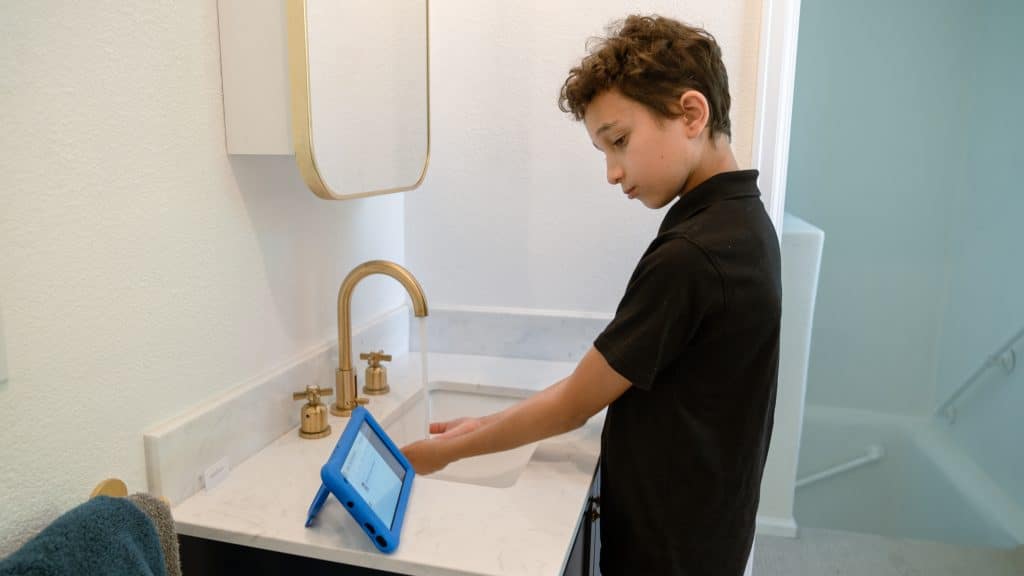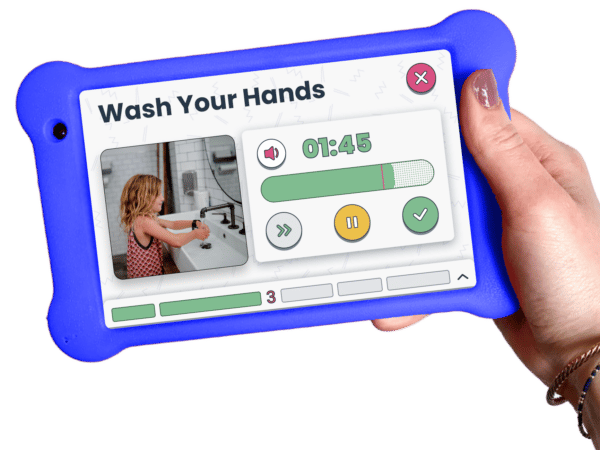Hand washing is a crucial skill for kids to learn, especially for maintaining good hygiene. In this guide, I’ll walk you through simple steps to make teaching hand washing easy and fun for your kids.
Key Takeaways
- Hand washing is essential for preventing the spread of germs.
- Use fun, engaging techniques to teach kids proper hand washing steps.
- Make sure to reinforce the habit with positive reinforcement and consistency.
What are the hand washing steps for kids? The hand washing steps for kids include wetting hands, applying soap, scrubbing all parts of the hands for 20 seconds, rinsing with water, and drying with a clean towel.
Table of Contents
Step 1: Wet Hands with Water
Start by guiding your kids to the sink and have them wet their hands with clean, running water. Explain that this step is essential because it helps remove any dirt or germs on the surface of their skin.
Encourage them to make sure both their hands are fully wet, including the backs of their hands and between their fingers. This will help ensure that the soap they apply in the next step can effectively clean all parts of their hands.
Step 2: Apply Soap
Next, show your kids how to apply soap to their wet hands. You can use a pump soap dispenser or a bar of soap, whichever is more convenient. Explain that soap is what helps to remove the germs that can make them sick.
Make sure they understand that they need to cover all surfaces of their hands with soap, including the backs of their hands, between their fingers, and under their nails. These are common places where germs like to hide.
Step 3: Scrub for 20 Seconds
One of the most critical steps is scrubbing the hands for at least 20 seconds. To make this fun, teach your kids to sing a short song, like “Happy Birthday” twice, or use a timer.
During this time, remind them to pay attention to all parts of their hands. Scrubbing helps break down and remove dirt and germs, making it a vital part of the hand washing process.

Read more: Teach Kids How to Wash Clothes
Step 4: Rinse with Clean Water
After scrubbing, it’s time to rinse off the soap. Guide your kids to use clean, running water to rinse their hands thoroughly. Make sure they remove all the soap, as leftover soap can cause skin irritation.
Encourage them to move their hands around under the water to ensure that all areas, including between the fingers and under the nails, are rinsed clean.
Step 5: Dry with a Clean Towel
The final step is drying their hands with a clean towel. Explain that drying their hands properly is important because germs can spread more easily on wet hands.
Show them how to use a towel or paper towel to dry all parts of their hands. If you’re using a reusable towel, remind them to only use it once and then replace it with a fresh one to avoid spreading germs.
Teach kids how to cough and sneeze considerately | A guide for parents.
Why Hand Washing is Important
Hand washing is one of the best ways to prevent the spread of illnesses, especially among kids who are more likely to come into contact with germs during playtime and other activities.
By teaching your kids proper hand washing techniques, you’re helping them build healthy habits that will benefit them for life. Research shows that regular hand washing can reduce the risk of respiratory infections by 21% [source].
Tips for Reinforcing Hand Washing Habits
Consistency is key when it comes to teaching kids new habits. Encourage your kids to wash their hands regularly, especially before eating, after using the bathroom, and after playing outside.
You can also use visual reminders, such as posters or stickers, near the sink to remind them of the steps. Positive reinforcement, like praise or small rewards, can also help make hand washing a fun and consistent part of their daily routine.

Fun Ways to Teach Hand Washing
Make hand washing fun by turning it into a game. For example, you can set up a “germ monster” challenge where your kids have to wash away the “germs” by following the steps correctly.
You can also use colorful soaps or special towels that they only get to use when they wash their hands. The more engaging and enjoyable you make it, the more likely they are to stick with the habit.
Teach your kids how to use a fork!
How to Encourage Independence in Hand Washing
As your kids get older, it’s important to encourage them to take responsibility for their own hand washing. Start by allowing them to go through the steps on their own while you supervise.
Over time, reduce the level of supervision as they become more confident and consistent. This not only helps them develop independence but also reinforces the importance of personal hygiene.

Goally | Best Videos to Teach Life Skills
Give your kid an independent future. Goally has 100+ video classes teaching life skills like “How to Choose a Restaurant,” “How to Interrupt Politely,” and “How to Get Ready for School.”
Goally takes kids on an adventure that includes interactive practice and checkpoints along the way! No web browsers, YouTube, or social media.
Teaching your kids the proper steps for hand washing is a simple yet powerful way to protect their health. By making it fun, consistent, and part of their daily routine, you’ll help them develop a lifelong habit that keeps them safe and healthy. Teach your kids how to wash their face too!
Helpful Resources
FAQs About Hand Washing Steps for Kids
Why is hand washing important for special needs kids? Hand washing is important for all children, but especially for those with special needs as they may have weaker immune systems or difficulty understanding the importance of cleanliness. Proper hand washing helps prevent the spread of germs and illnesses. What are the five steps to proper hand washing for kids? The five steps to proper hand washing are: wet hands with clean water, lather hands with soap, scrub hands for at least 20 seconds, rinse hands thoroughly with clean water, and dry hands with a clean towel or air dry. How can parents and caregivers teach special needs kids to wash their hands properly? Teaching special needs kids to wash their hands properly can be challenging, but it can be done through visual aids, repetition, and positive reinforcement. Parents and caregivers can also use fun songs or videos to make hand washing more engaging and enjoyable. How often should special needs kids wash their hands? Special needs kids, like all children, should wash their hands frequently throughout the day, especially before and after eating, using the restroom, or touching objects that may be contaminated with germs. What are some tips for making hand washing easier for special needs kids? Some tips for making hand washing easier for special needs kids include: providing a step stool or comfortable seating, using soap with a pleasant scent or texture, and providing plenty of visual aids and positive reinforcement to encourage proper hand washing habits.
This post was originally published on 12/28/2020. It was updated on 08/22/2024.
Emily is a seasoned blog writer for Goally, leveraging her extensive background in child psychology and special education to provide valuable insights and resources for parents. Her commitment to understanding and addressing the unique needs of these children, combined with her expertise in educational strategies, makes her a credible and empathetic voice for families.





